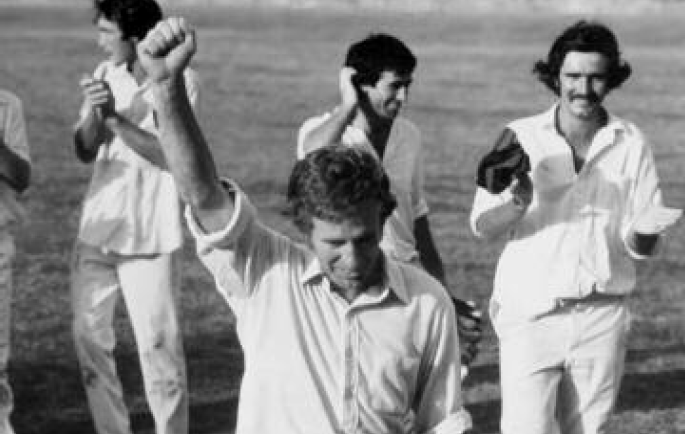The captaincy skills of John Rogers
Paul Ryan | March 05, 2024

Chris Chapman has some experience of leadership. He headed up the construction of the Sydney Olympic Stadium; he’s been CEO of the Seven Network and of the Optus Broadband rollout (in the heady days of the first Dotcom era), and was the inaugural Executive Chairman of the Federal Government's Australian Communications and Media Authority – all of which has led to his current directorship of ICANN, the world body that regulates the DNS systems (and associated technical aspects) of the Internet. And as the recently retired President of the Royal Sydney Golf Club, he secured the myriad of approvals required for an ambitious $30m re-build of the Royal Sydney Championship golf course. All of which means marshalling and leading hundreds of people in many different contexts. He is a passionate sports follower: he has attended several Olympic Games, US Masters and British Open Golf, Wimbledon, World Cup Finals - and each year he attends the Sydney Test. As a player, he won two Sydney First Grade premierships during his 13 years in the top grade - during which he played under 8 different captains.
..............................................................................
For many years, I’ve had the good fortune of speaking to several University of New South Wales cricketers who played under the leadership of John Rogers.
John was the captain of the UNSW first grade team when they won the first-grade premiership in Sydney Grade Cricket for the first time in 1976–77.
To this day, the players speak so highly of John Rogers. These men are now in their 60s, yet the reverence and esteem they hold for John is wonderful and inspiring.
Since the moment I met John many years ago at a Sydney test match surrounded by four of his UNSW players, I’ve wanted to know more about his captaincy and leadership.
In response to a request, Chris Chapman wrote this about John Rogers:
“In 2007 I wrote an article for “Five Seasons, Five Flags”, the UNSWCC 30 Year Celebration publication marking its first 1st Grade premiership win in late March 1977.
The article was titled “What If I’d Dropped It?” because, with Petersham needing 10 runs to win (and the last wicket having put on 46, yes, 46), all eyes turned to me at deep square-leg. As I wrote: “A lofted slog was heading my way and UNSWCC was a fraction of a second – a very long fraction – away from the most improbable 1st Grade premiership ever, given that UNSWCC had only been in the 1st division of Sydney cricket for just 4 seasons.”
Our team-mate (and the bowler of that delivery), Mark Ray, said this of that moment: “as most of us expected, Chappo took the catch with typical ease although he had to run in and to his right a fair way.”
That was not quite how I saw it, as the late afternoon sun was a complicating factor, resulting in a fractured finger in taking the catch - a very small price to pay.
It proved to be the final ball bowled in a match that saw epic fluctuations in both teams’ fortunes: UNSWCC had firstly reached 284 after being 6 for 107, while Petersham- Marrickville (with five Shield players) was now 9 for 275, when earlier, it had been cruising at 3 for 196, before slumping to 9 for 229.
My piece ruminated that, over those 30 years, two things had consistently worried me: what if I’d dropped it and Petersham had won; and how did such an inexperienced and unheralded team (with limited experience and untested newcomers) pull off that great victory?
Since that time I’ve mixed with Presidents, Prime Ministers, Chief Justices and diplomats, and even been held against my will in a remote part of Turkey. I’ve been marched by Kerry Stokes, suffered damning character assessments in Senate Estimates hearings and by any number of amoral corporate and media types. But I only look back and cogitate on one comparatively obscure thing: “what if I’d dropped it and Petersham had won?” The thought of it sickens me to this day; the shame of it would have been insufferable, the next 30 years oh so different; all the slings and arrows I’ve copped in my professional and personal life would have been mere trifles compared to that prospect.
At the time of writing the piece, I shared with our captain John Rogers, my obsessive anxiety over the first question. He seemed surprised that it still stayed with me but, as a mark of the man and the reason why I have come to regard him as the finest leader of men (whether on or off a playing field) that I have been associated with, he responded matter-of-factly: “We still would have won, Chappo.”
The thought that the UNSWCC 1st Grade side might win the flag in during just its 4th season had been a mere pipedream to all we “wet-behind-the-ears” students who made up the rest of that team. In fact, we had “frozen" when Petersham had collapsed to 9 down with 56 to get. Future test legend Geoff Lawson - then aged just 19 - gave up 16 runs in an over. Our fielding went haywire.
But we hung on to win. That we did so lay primarily in the psyche and skills of our captain, John Rogers (father of Test batsman, Chris Rogers) and universally known as ‘JR’. He’d had the experience of winning four premierships and, when needed at that critical juncture, it showed. In my view, he was without peer in his ability to lead, to inspire and to conjure. His orchestration and the confidence he exuded were the touchstones upon which that impossible dream played out.
Chris Chapman is seated in the front row second in from the left with John Rogers in the middle of the front row
In retrospect, it was not by luck we had got to that moment of winning. Three weather-affected draws had us low on the table early in the season, and we had to claw our way back. We'd held our nerve to chase down imposing totals. We’d held off run-chases that looked certain to swamp us. No less than 8 world legends of the game were in opposing teams: Boycott (England), Andy Roberts (Windies), Border, Walters, Simpson, Booth, Pascoe and McCosker. All up we’d been opposed to no less than 40 players who had, or would, play 1st class cricket. Both the Semi-final and Final weekends were played in perfect weather with no advantage to either team and, having prevailed against the best and worst of Lenny Pascoe in the Semi, we toughed it out in the Final - against the toughest and meanest club in the competition on its home ground, recovering twice from situations that had us staring at defeat.
A year later, our 2nd Grade side, playing the same brand of cricket JR had brought to the club, would win the premiership. Further proof that we students were no longer just a ratbag mob of cricket wannabes was the winning of the Club Championship a season later - JR’s last before heading to WA as WACA General Manager. There he helped bring together the warring superstars Dennis Lillee, Rod Marsh and Kim Hughes to win several Sheffield Shield and national one-day titles.
Final proof of the UNSWCC’s progress came a further two years later when a second 1st Grade premiership was secured under Mark Ray’s gifted leadership. This time the UNSWCC was top dog from start to finish, with many of the same players. The youngsters had matured by then and were more orthodox, but the will to win had not been tempered.
I often wonder where that will came from: whether you have it innately, whether you develop it or somehow you just absorb it, osmosis-like. My takeout: I think we were led to it by JR, for whose friendship, collegiality and mentorship, and the unrepeatable camaraderie of that unheralded group, I remain eternally grateful.”

